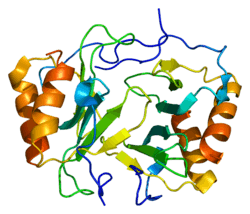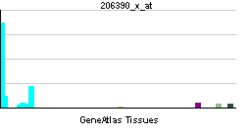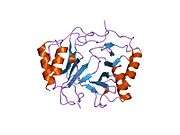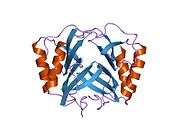Platelet factor 4
Platelet factor 4 (PF4) is a small cytokine belonging to the CXC chemokine family that is also known as chemokine (C-X-C motif) ligand 4 (CXCL4) . This chemokine is released from alpha-granules of activated platelets during platelet aggregation, and promotes blood coagulation by moderating the effects of heparin-like molecules. Due to these roles, it is predicted to play a role in wound repair and inflammation.[1] It is usually found in a complex with proteoglycan.
Genomics
The gene for human PF4 is located on human chromosome 4.[2]
Function
Platelet factor-4 is a 70-amino acid protein that is released from the alpha-granules of activated platelets and binds with high affinity to heparin. Its major physiologic role appears to be neutralization of heparin-like molecules on the endothelial surface of blood vessels, thereby inhibiting local antithrombin III activity and promoting coagulation. As a strong chemoattractant for neutrophils and fibroblasts, PF4 probably has a role in inflammation and wound repair.[1][3]
PF4 is chemotactic for neutrophils, fibroblasts and monocytes, and interacts with a splice variant of the chemokine receptor CXCR3, known as CXCR3B.[4]
Clinical significance
The heparin:PF4 complex is the antigen in heparin-induced thrombocytopenia, an idiosyncratic autoimmune reaction to the administration of the anticoagulant heparin.[5] PF4 autoantibodies have also been found in patients with thrombosis and features resembling HIT but no prior administration of heparin.[6]
The human platelet factor 4 kills malaria parasites within erythrocytes by selectively lysing the parasite's digestive vacuole.[7]
References
- 1 2 Eisman R, Surrey S, Ramachandran B, Schwartz E, Poncz M (July 1990). "Structural and functional comparison of the genes for human platelet factor 4 and PF4alt". Blood 76 (2): 336–44. PMID 1695112.
- ↑ O'Donovan N, Galvin M, Morgan J (1999). "Physical mapping of the CXC chemokine locus on human chromosome 4". Cytogenet Cell Genet 84 (1–2): 39–42. doi:10.1159/000015209. PMID 10343098.
- ↑ "Entrez Gene: PF4 platelet factor 4 (chemokine (C-X-C motif) ligand 4)".
- ↑ Lasagni L, Francalanci M, Annunziato F, Lazzeri E, Giannini S, Cosmi L, Sagrinati C, Mazzinghi B, Orlando C, Maggi E, Marra F, Romagnani S, Serio M, Romagnani P (2003). "An alternatively spliced variant of CXCR3 mediates the inhibition of endothelial cell growth induced by IP-10, Mig, and I-TAC, and acts as functional receptor for platelet factor 4". J Exp Med 197 (11): 1537–1549. doi:10.1084/jem.20021897. PMC 2193908. PMID 12782716.
- ↑ Warkentin TE (March 2007). "Drug-induced immune-mediated thrombocytopenia--from purpura to thrombosis". N. Engl. J. Med. 356 (9): 891–893. doi:10.1056/NEJMp068309. PMID 17329695.
- ↑ Warkentin TE, Makris M, Jay RM, Kelton JG (July 2008). "A spontaneous prothrombotic disorder resembling heparin-induced thrombocytopenia". Am. J. Med. 121 (7): 632–636. doi:10.1016/j.amjmed.2008.03.012. PMID 18589060.
- ↑ Love MS, Millholland MG, Mishra S, Kulkarni S, Freeman KB, Pan W, Kavash RW, Costanzo MJ, Jo H, Daly TM, Williams DR, Kowalska MA, Bergman LW, Poncz M, Degrado WF, Sinnis P, Scott RW, Greenbaum DC (December 2012). "Platelet Factor 4 Activity against P. falciparum and Its Translation to Nonpeptidic Mimics as Antimalarials". Cell Host Microbe 12 (6): 815–23. doi:10.1016/j.chom.2012.10.017. PMID 23245326.
Further reading
- Bikfalvi A, Gimenez-Gallego G (2004). "The control of angiogenesis and tumor invasion by platelet factor-4 and platelet factor-4-derived molecules". Semin. Thromb. Hemost. 30 (1): 137–144. doi:10.1055/s-2004-822978. PMID 15034805.
- Maurer AM, Zhou B, Han ZC (2007). "Roles of platelet factor 4 in hematopoiesis and angiogenesis". Growth Factors 24 (4): 242–252. doi:10.1080/08977190600988225. PMID 17381065.
- Deuel TF, Keim PS, Farmer M, Heinrikson RL (1977). "Amino acid sequence of human platelet factor 4". Proc. Natl. Acad. Sci. U.S.A. 74 (6): 2256–2258. doi:10.1073/pnas.74.6.2256. PMC 432148. PMID 267922.
- Walz DA, Wu VY, de Lamo R, et al. (1978). "Primary structure of human platelet factor 4". Thromb. Res. 11 (6): 893–898. doi:10.1016/0049-3848(77)90117-7. PMID 601757.
- Nath N, Lowery CT, Niewiarowski S (1975). "Antigenic and antiheparin properties of human platelet factor 4 (PF4)". Blood 45 (4): 537–50. PMID 803847.
- Hermodson M, Schmer G, Kurachi K (1977). "Isolation, crystallization, and primary amino acid sequence of human platelet factor 4". J. Biol. Chem. 252 (18): 6276–9. PMID 893407.
- Maione TE, Gray GS, Petro J, et al. (1990). "Inhibition of angiogenesis by recombinant human platelet factor-4 and related peptides". Science 247 (4938): 77–79. doi:10.1126/science.1688470. PMID 1688470.
- Han ZC, Bellucci S, Tenza D, Caen JP (1990). "Negative regulation of human megakaryocytopoiesis by human platelet factor 4 and beta thromboglobulin: comparative analysis in bone marrow cultures from normal individuals and patients with essential thrombocythaemia and immune thrombocytopenic purpura". Br. J. Haematol. 74 (4): 395–401. doi:10.1111/j.1365-2141.1990.tb06325.x. PMID 2140694.
- Poncz M, Surrey S, LaRocco P, et al. (1987). "Cloning and characterization of platelet factor 4 cDNA derived from a human erythroleukemic cell line". Blood 69 (1): 219–23. PMID 3098319.
- Griffin CA, Emanuel BS, LaRocco P, et al. (1987). "Human platelet factor 4 gene is mapped to 4q12----q21". Cytogenet. Cell Genet. 45 (2): 67–69. doi:10.1159/000132431. PMID 3622011.
- Senior RM, Griffin GL, Huang JS, et al. (1983). "Chemotactic activity of platelet alpha granule proteins for fibroblasts". J. Cell Biol. 96 (2): 382–385. doi:10.1083/jcb.96.2.382. PMC 2112304. PMID 6187750.
- Morgan FJ, Begg GS, Chesterman CN (1980). "Complete covalent structure of human platelet factor 4". Thromb. Haemost. 42 (5): 1652–60. PMID 6445090.
- Deuel TF, Senior RM, Chang D, et al. (1981). "Platelet factor 4 is chemotactic for neutrophils and monocytes". Proc. Natl. Acad. Sci. U.S.A. 78 (7): 4584–4587. doi:10.1073/pnas.78.7.4584. PMC 319837. PMID 6945600.
- Brown KJ, Parish CR (1994). "Histidine-rich glycoprotein and platelet factor 4 mask heparan sulfate proteoglycans recognized by acidic and basic fibroblast growth factor". Biochemistry 33 (46): 13918–13927. doi:10.1021/bi00250a047. PMID 7524669.
- Mayo KH, Roongta V, Ilyina E, et al. (1995). "NMR solution structure of the 32-kDa platelet factor 4 ELR-motif N-terminal chimera: a symmetric tetramer". Biochemistry 34 (36): 11399–11409. doi:10.1021/bi00036a012. PMID 7547867.
- Barker S, Mayo KH (1995). "Quarternary [sic] structure amplification of protein folding differences observed in 'native' platelet factor-4". FEBS Lett. 357 (3): 301–304. doi:10.1016/0014-5793(94)01384-D. PMID 7835432.
- Zhang X, Chen L, Bancroft DP, et al. (1994). "Crystal structure of recombinant human platelet factor 4". Biochemistry 33 (27): 8361–8366. doi:10.1021/bi00193a025. PMID 8031770.
- Horne MK (1993). "The effect of secreted heparin-binding proteins on heparin binding to platelets". Thromb. Res. 70 (1): 91–98. doi:10.1016/0049-3848(93)90226-E. PMID 8511754.
- Kolset SO, Mann DM, Uhlin-Hansen L, et al. (1996). "Serglycin-binding proteins in activated macrophages and platelets". J. Leukoc. Biol. 59 (4): 545–54. PMID 8613703.
See also
External links
- Platelet factor 4 at the US National Library of Medicine Medical Subject Headings (MeSH)
| |||||||||||||||||||
| ||||||||||||||||||||||||||||||||||||||||||||||||||||||||||||||||||||||||||||||||||
| ||||||||||||||||||||||||||||||||||||||
This article incorporates text from the United States National Library of Medicine, which is in the public domain.







